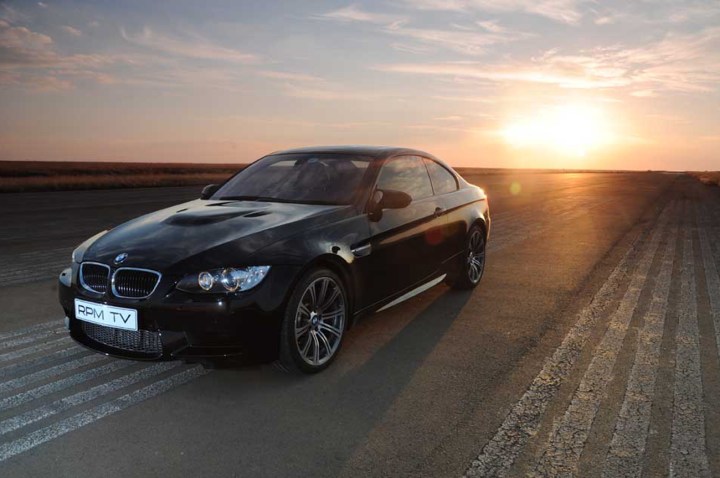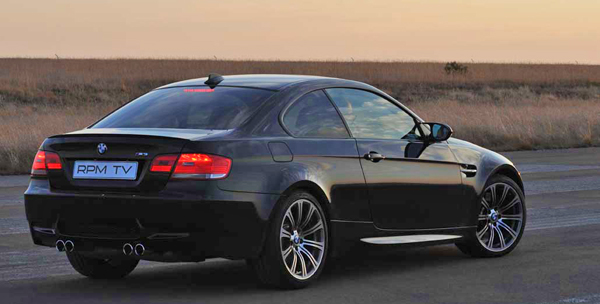Business Maverick, Sci-Tech
BMW M3 Coupé M-DCT: A street fighter with velvet gloves

BMW’s M Division is more than just a token badge on a go-faster machine. It’s a serious motor company developing bespoke performance car solutions based on BMW’s production car range. Which means there’s a whole lot more to the BMW M3 than some extra horses under the bonnet and a set of fancy wheels. Yes, it looks like a mildly modified 3-Series Coupé. But under that bugling bonnet beats the heart of a thoroughbred.
The M-cars in BMW’s stable have built up something of a reputation for giant-killing feats, often against some of the more fancied machinery in the sports car world. But none of its cars enjoys the almost universal appeal and adulation of the M3.
Every successive generation of the BMW’s best-selling 3-Series – from the original E30 of the early 1980s to the current model – has spawned an M3. And each time, the resulting car has endeared itself to owners and aficionados, while raining on the sport car parade.
And who can blame the owner of an acknowledged thoroughbred becoming thoroughly fed up if his exotic steed is beaten by a car that, let’s be honest, doesn’t look that much different from the common or garden 3-Series parked in the neighbour’s garage.
The latest, fourth generation M3 is not only the most advanced of its ilk, but also the largest and the most expensive. There’s nothing svelte about the two-door coupé and the shape, while clearly athletically proportioned, is unremarkable, at least at first glance.
Yes, it’s instantly recognisable as BMW. And as a member of the 3-Series clan. But you need to step closer to identify the ‘M’ badges, the chrome-delineated gills in the front fenders, the large, spoked alloy wheels and the equally generous drilled brake discs.
Other distinguishing visual clues include the rather ungraceful, even brutish bulge in the centre of the bonnet, and the large exhaust tailpipes jutting out from the rear, diffuser-shaped apron – although, by muscle-car standards, those exhausts still appear understated.
This M3 made its bow in 2007, and there are several reasons why die-hard M loyalists were initially less than enamoured of the car’s arrival. Perhaps the most important of these was the replacement of BMW’s legendary straight-six performance engine.

That powerplant’s sound was so integral to the modern M3’s persona that the mere thought of one without it was tantamount to automotive heresy. That didn’t deter BMW from shoving a compact V8 into the M3’s engine bay – and explains why that bonnet bulges the way it does.
The second break from M3 tradition was the availability, for the first time, of a dual-clutch gearbox. This clutchless system allows lightning-fast gear changes using Formula One-style paddles behind the steering wheel. And given BMW’s involvement in F1 at the time of the M3’s release, both the gearbox and the V8 engine draw direct parallels between the road car and the racing car – clearly an attractive marketing angle.
Traditionalists may have been annoyed by this departure from the M3 norm, but the truth is that the current M3 Coupé is also the finest to date. The 4,0-litre V8 is nothing like the lazy, slow-revving, high-torque monstrosities that dominate the innards of American muscle machinery.
Instead, it draws heavily on F1 racing know-how, and displays an appetite for revs quite uncanny in the V8 context. At normal operating temperatures, the power unit revs eagerly to 8 000rpm and beyond, while emitting a sound that’s almost blood-curdling in its sheer, guttural intensity.
The dynamic impact of the 309kW eight-potter is best described as menacing. There’s nothing at all subtle about the way you get shoved back into your contoured seat when you floor the throttle.
The accompanying 400Nm of torque ensure that the accelerative forces continue to pin you down as the speedometer’s crimson needle spins around the face with dizzying alacrity. The experience may be considered intimidating by some – especially as it’s accompanied by the engine’s angry, banshee wail.
It doesn’t take rocket science to realise that the nostalgic appeal of the straight-six engine has long ago faded into obscurity. But the dual-clutch transmission, known as M-DCT in BMW M-speak, remains a rather more controversial subject.
For all their promises of rapid, sequential-style gearshifts, dual-clutch gearboxes don’t offer the direct, visceral engagement with the drivetrain offered by a good old manual stick shift. There’s something remote and ephemeral about tapping a shift paddle: It just doesn’t have the mechanical palpability of the gear lever.
However, let’s not remain blind to the onward march of technology. Dual-clutch transmissions are now widely used, and the M-DCT is one of the finest. We can also attest to the fact that the software controlling the transmission has improved vastly in the two years or so since we last drove a dual-clutch equipped M3.

So, we have a sophisticated, high-revving V8 harnessed by an equally sophisticated dual-clutch gearbox. Much of the rest of the package is race-bred and pure M.
Big, drilled brake discs provide retardation equal to the car’s dynamic potential. An independent suspension system employs lightweight aluminium components to reduce unsprung mass and aid the M3’s road manners. And a stiff body shell ensures intuitive handling and direct dialogue between car and driver.
Perhaps that’s the core element of the M-car philosophy – and one closely adhered to by this M3: Behind the wheel, the driver realises that the Bavarian coupé is a finely honed, meticulously engineered machine focussed solely on translating intent into raw, tar-ripping action.
But first, like a pilot undergoing a conversion to a new aircraft type, you need to familiarise yourself with the M3’s controls and switchgear, some of which will be completely foreign to anyone driving a normal car.
The heavily contoured seats are electrically adjustable in every plane, as is the steering column carrying the small, thick-rimmed, leather-trimmed steering wheel. Nothing too unusual there. But delve into the car’s user interface, graphically displayed on a high-resolution screen, and you’ll find a set of parameters vital to extracting the best from the M3.
Thus, the suspension characteristics can be altered from merely firm to outright sporty. A power setting maps the engine electronics to ensure that all 309kW are instantly accessible, while also sharpening the throttle response and the power steering action.
Even the way the engine’s urge is translated to the rear wheels, and how much wheelspin and traction control is enforced, can be tweaked to suit the driver’s confidence – or aptitude. And the key settings can be stored as individual preferences, and then called up at the push of a button on the steering wheel. Think Gran Turismo for grown ups …
The much improved iDrive user interface works in tandem with a high-resolution colour screen to allow almost every aspect of the BMW to be altered and adjusted. Depending on the equipment level ordered, there’s even a hard drive that provides storage for your favourite music.
But the M3’s interior is more than a repository for high technology. It’s a comfortable place, with the seats providing superior support, and the climate control keeping interior temperatures just right.
Most of the luxury bells and whistles are at the occupants’ beck and call, and the rear seating is feasible for adult use, although some may consider the accommodation claustrophobic. Even the boot, at 480-litres, is generous enough for large suitcases, or golf bags.
However, let’s not forget that the M3 is a performance machine – and performance is what it excels at. With a power-to-weight ratio of 193kW/ton, and the rapid-fire gear swops of the M-DCT transmission, the BMW slingshots away when you boot the accelerator.
The factory figures claim a 0-100km/h sprint time of 4,6 seconds, which is 0,2 seconds faster than the normal, manual-gearbox version can muster. Top speed remains limited to 250km/h, in accordance with the gentlemen’s agreement between Germany’s luxury marques – but we have it on good authority that, unhindered by such electronics, the M3 would run to in excess of 280km/h.
However, it’s the overall driving experience that pushes the M3 into true sports car territory. It slices through curves and corners with the finesse of a finely honed blade, displaying a level of balance and composure that seems gravity defying.
At the same time, the full impact of the dynamic experience – the lateral g-forces, the way the fat Michelin Pilot Sport tyres squirm for grip, the hoarse cry of the engine – is retained, to be savoured and explored by the driver (and, sometimes, to intimidate the passengers).
Driving the M3 in a way to fully exploit its dynamic potential is an intoxicating treat – but an increasingly rare one. And there’s the rub: the true value of this car lies in making the most of its astounding talents. But finding opportunities to do so are increasingly difficult.
To robot-race it in urban environments is boorish and ultimately unsatisfying. It also isn’t a popular practice with other road users. And it cheapens what the M3 is truly capable of.
Instead, the coupé’s real habitat is the roller-coaster ride of a remote mountain pass, the flat-out straight of a deserted tarmac stretching into the Karoo’s shimmering heat – or the burning rubber and the rivalry of a track day at a racing circuit.
Yes, the M3 is civilised enough to be driven like a luxury coupé. It will potter around suburbia without complaint and perform the daily commute on congested roads with slick assurance. The M-DCT gearbox can be switched to full auto mode, adding further convenience.
But there are other cars, and other BMWs, that perform those mundane motoring tasks with greater aplomb for less money. The M3 needs space, demands the open road, insists on being exercised. The challenge is to find those opportunities.
Of course, it’s a dilemma not unique to BMW M3 owners, but one with which all sports car drivers have to contend. The difference is that not too many thoroughbred sports cars offer the four-seat convenience and the space of the Beemer.
At R907 600 before options, an M3 in a commuter role is an expensive indulgence. But considering the visceral driving experience, and the considerable dynamic potential on offer, this street fighter with velvet gloves remains high on our list of great cars – as long as you get to savour its very real talents.
By Deon Schoeman
[email protected]
VITAL STATS
BMW M3 Coupé M-DCT
Engine
3 999 cc V8, DOHC per bank
Gearbox
Six-speed dual-clutch transmission
Power
309 kW at 8 300 rpm
Torque
400 Nm @ 3 900 rpm
0-100 km/h
4,6 sec
Top speed
250 km/h (limited)
Fuel consumption
15,4 litres/100 km (tested)
Carbone dioxide emissions
263 g/km
Retail price
R907 600


















 Become an Insider
Become an Insider